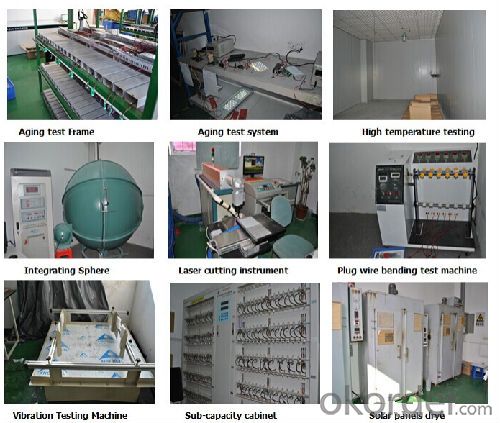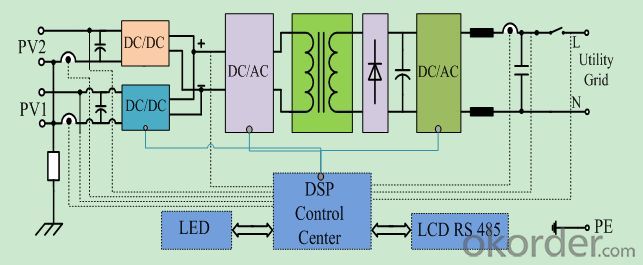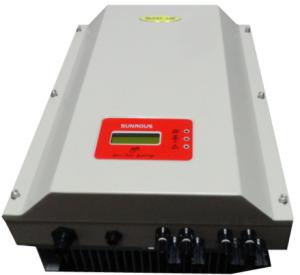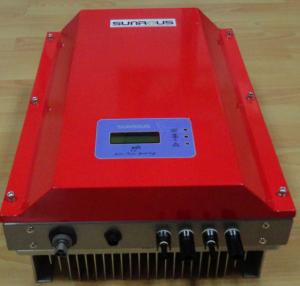Grid-Tied Inverter Dual MPPT Made in China with Good Price
- Loading Port:
- Shanghai
- Payment Terms:
- TT or LC
- Min Order Qty:
- 100 mm
- Supply Capability:
- 500 mm/month
OKorder Service Pledge
OKorder Financial Service
You Might Also Like
·High frequency transformer isolation and conversion efficiency rate up to 97%.
·Dual input sections with independent MPP tracking, allows optimal energy harvesting from two sub-arrays oriented in different directions
· High speed and precise MPPT algorithm for real time power tracking and improved energy harvesting, as well as regular MPP Adaptation Efficiency of over 99.0%.
·Flat efficiency curves ensure high efficiency at all output levels ensuring consistent and stable performance across the entire input voltage and output power range
·Wide input DC MPPT range(150V~550V)/output AC voltage range (180V~264V)
·IP 65/NEMA 3R, outdoor enclosure for unrestricted use under any environmental conditions
·Any modules can be used and fit in this device whether crystalline or thin-film.
·Use in residential applications requiring PV array plug-in grounding.
·RS-485 communication interface (designed for connection to computer or data-logger)
·Easy to install and operate with reduced weight.


High frequency transformer isolation is the main feature of our production, which makes Installation easier due to the reduced weight and higher conversion effciency because of omitting Low frequency transformer. The wide input voltage range from 180 to 600voltage gives you extraordinary fexibility for you system design. Not need to set graphic display and RS485 communication system make the devices highly user-friendly.
This product can by multi-level parallel combination for 6kw to 20kw needed any power grade HF series technical parameter.
certificates:
American ETL certification
- GT2.0-ZX-01/HF
- GT3.0-ZX-01/HF
The European TUV certification
- GT2.0-ZX-01
- GT2.5-ZX-01
- GT3.0-ZX-01
The British G59 authentication
- GT3.8-ZX-01
- GT5.0-ZX-01
The British G83 authentication
- GT2.0-ZX-01
- GT2.5-ZX-01
- GT3.0-ZX-01
Model No. | PR-SAS300 |
Polycrystalline solar panel | 2pcs 75Wp parallel |
Max. solar panel charging voltage | 17.6V |
Max. solar panel charging current | 8.54A |
Inverter output | Pure sine wave 300W |
Inverter peak start | 900W (3s) |
Inverter output voltage/frequency | 220V/50Hz |
Inverter AC charger | 12V/10A |
Solar charge controller | 12V/15A |
Cabinet material | Steel box of zinc-plated and lacquer-coated |
Battery type | Deep cycle maintenance free |
Battery capacity | 1 x 12V 100Ah |
Operating temperature | -20oC-55oC |
Packing for solar panel | 0.06cbm/20kg |
Packing for integrated solar charge control inverter cabinet | 0.11cbm/15kg |
Packing for battery | 0.02cbm/31kg |
Whole system per set | 0.19cbm/66kg |
Optional monitoring software | CD-ROM for computer and SNMP card for internet |
Q1 : What is you advantages
A1:
a).We are professional ups manufacturer for more than ten years and we have these staffs with rich
production and R&D
b) Excellent workers and skilled engineers
c).Our aims are to provide every customer high quality, reasonable price and excellent
service.
d)we can guarantee to send the goods on time. And also accept any transportation ways that
you require
Q2 : How do you control the production quality
A2:
a) For materials, we have IQC departments and the IQC testing follow MIL-STD-105E standard
b) in production have 4 times function testing
c) all of our products with 100% burn-in testing
d) 100% QC testing before delivery
- Q:How long do solar inverters typically last?
- Solar inverters typically have a lifespan of around 10 to 15 years. However, the actual longevity can vary depending on factors such as the quality of the inverter, maintenance, and environmental conditions.
- Q:Can a solar inverter be installed indoors or outdoors?
- A solar inverter can be installed both indoors and outdoors, depending on the specific requirements and preferences of the installation.
- Q:How does a solar inverter synchronize with the grid?
- A solar inverter synchronizes with the grid by continuously monitoring the grid's voltage and frequency. It adjusts its own voltage and frequency accordingly to match the grid, allowing the solar power to flow seamlessly into the grid. This synchronization is important to ensure the safe and efficient operation of the solar power system, as well as to prevent any disturbances or damage to the grid.
- Q:Can a solar inverter be used with bifacial solar panels?
- Yes, a solar inverter can be used with bifacial solar panels. Bifacial solar panels have the ability to capture sunlight from both sides, making them more efficient. A solar inverter is responsible for converting the DC power generated by solar panels into usable AC power for homes or businesses. Therefore, it can easily be used with bifacial solar panels to ensure efficient power conversion and utilization.
- Q:How does a solar inverter handle anti-islanding protection?
- A solar inverter handles anti-islanding protection by continuously monitoring the grid's voltage and frequency. If the grid's voltage or frequency deviates from the predetermined range, indicating a potential islanding condition, the inverter quickly disconnects from the grid to prevent energy flow. This ensures the safety of utility workers and prevents damage to the electrical grid.
- Q:What is the role of Maximum Power Point Tracking (MPPT) in a solar inverter?
- The role of Maximum Power Point Tracking (MPPT) in a solar inverter is to optimize the power output from the solar panels by constantly adjusting the voltage and current to ensure that the solar panels are operating at their maximum power point. This allows the solar inverter to efficiently convert the DC power generated by the solar panels into AC power for use in homes or businesses. By tracking and adjusting the maximum power point, MPPT technology maximizes the overall energy production and improves the overall efficiency of the solar inverter system.
- Q:Can a solar inverter be used with solar-powered ventilation systems?
- Yes, a solar inverter can be used with solar-powered ventilation systems. A solar inverter is responsible for converting the direct current (DC) produced by solar panels into alternating current (AC) that can be used to power various electrical devices, including ventilation systems. By connecting the solar panels to a solar inverter, the generated solar energy can be efficiently utilized to operate the ventilation system, ensuring a sustainable and eco-friendly ventilation solution.
- Q:How does MPPT technology work in solar inverters?
- MPPT (Maximum Power Point Tracking) technology in solar inverters works by continuously adjusting the operating voltage and current of the solar panels to ensure the maximum power output. It does this by constantly monitoring the voltage and current of the solar panels and finding the optimal point (maximum power point) at which the panels can deliver the most power. This is achieved by varying the load on the panels to match their impedance with the maximum power point. MPPT technology maximizes the efficiency of solar power generation by extracting the maximum available power from the panels under varying environmental conditions such as shading, temperature changes, and panel degradation.
- Q:Can a solar inverter be used with any type of solar panel?
- No, a solar inverter cannot be used with any type of solar panel. The compatibility between the solar inverter and solar panel depends on the type of technology used in the solar panel, such as monocrystalline, polycrystalline, or thin-film. It is essential to match the specifications and voltage requirements of the solar inverter with the solar panel to ensure efficient and safe operation.
- Q:How does a solar inverter handle voltage phase imbalance in the grid?
- A solar inverter handles voltage phase imbalance in the grid by continuously monitoring the grid's voltage and frequency. If it detects any phase imbalance, it adjusts its output to balance the voltage across all phases. This ensures that the power generated by the solar panels is synchronized with the grid and prevents any issues that may arise due to phase imbalances, such as equipment damage or power quality issues.
1. Manufacturer Overview |
|
|---|---|
| Location | |
| Year Established | |
| Annual Output Value | |
| Main Markets | |
| Company Certifications | |
2. Manufacturer Certificates |
|
|---|---|
| a) Certification Name | |
| Range | |
| Reference | |
| Validity Period | |
3. Manufacturer Capability |
|
|---|---|
| a)Trade Capacity | |
| Nearest Port | |
| Export Percentage | |
| No.of Employees in Trade Department | |
| Language Spoken: | |
| b)Factory Information | |
| Factory Size: | |
| No. of Production Lines | |
| Contract Manufacturing | |
| Product Price Range | |
Send your message to us
Grid-Tied Inverter Dual MPPT Made in China with Good Price
- Loading Port:
- Shanghai
- Payment Terms:
- TT or LC
- Min Order Qty:
- 100 mm
- Supply Capability:
- 500 mm/month
OKorder Service Pledge
OKorder Financial Service
Similar products
New products
Hot products
Hot Searches
Related keywords
































